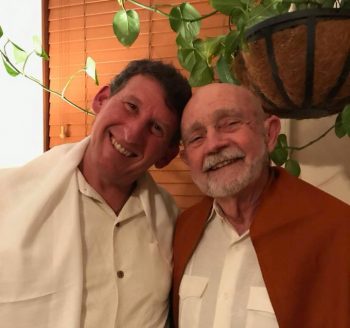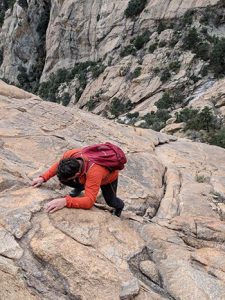
If you’ve never gone on a silent solo meditation retreat, you might wonder why anyone would do this. There are many good reasons, but for the purpose of this blog, self-exploration is the focus. For me, this means exploring the somatics of the body in relationship to contemplation and my mind.
I am just back from a nearly two-week solo meditation retreat at Cochise Stronghold Retreat. Cochise Stronghold is in the Chiricahua Mountains Range in southeastern Arizona. This area is rich with history. The Chiricahua Mountains are rugged granite crags above the Sonora desert. Filled with cactus, stinging insects and reptiles, and plants wearing heavy-armor, rugged is an understatement. This range was home to the Chiricahua Apache Native Americans.

This particular section of the Dragoon Mountains is where Chief Cochise held off the US Calvary during the mid-1800’s. The famous Geronimo was the right arm of Chief Cochise. Geronimo, a notoriously tough warrior, learned his landscape navigational skills amid the granite crags of Cochise Stronghold. During my daily hikes I would go off trail and imagine the kinds of rites of passage the Apache warriors might have engaged in that developed their skills to survive in this unforgiving magnificent land.
This section of the Sonoran desert is particularly wonderful for a meditation retreat. Cochise Stronghold Retreat is located on a canyon floor. The rugged skyline of granite peaks cap the spectacular view, contrasting against the deep blue sky. This area is famous for a rugged style of rock climbing that has roots in traditional ethics – meaning bold, ground up style of climbing that is rich with adventure and exposure.
I also like my retreats in bold style. This retreat I focused on somatics by immersing myself in kinesthetic and sensory awareness. The days were filled with a rich sensory environment. The mental heavy lifting was in the evening.
My retreat schedule had a “retreat-light” kind of regimen – opting for plenty of rest and relaxation — though the immersion was anything but light. My morning practices were indoors in the silence of my own mind. The afternoons I went outside for long hikes, easy bouldering, and some shop work as my seva (service) project.

Through the lens of somatics, I supercharged the classic four positions of meditation: seated, standing, walking, and lying-down.
I started with movement preliminaries. These transitioned into the dedication of practice. Then I would engage in an extensive walking practice. The nervous system was now ready for a reset in a lying practice. This was then followed with a seated practice – capped by dedicating the merit of the practice to all beings, as well as some friends and family who could use a little extra blessing. Each aspect of this sequence is interdependent with that which came before and the practices are complementary. The summation of the integrated whole is greater than the practice of each individual component.
The following is a summary of each of the aspects of this mindful movement practice:
Preliminaries:
The preliminaries prime the nervous system for that which follows. The preliminaries start with waking up the kinesthetic awareness in the feet. Then movement work progresses to full body.
Here is the list of progressions:
- loading the calcaneus in inversion and eversion
- lateral blade loading to activate the cuboid spring
- loading the ball of foot to activate the navicular spring
- making a circle from calcaneus through the forefoot
- ball and foot squat with toes together, knees swing side to side to activate the cuneiform spring
- Toe activation- lift, spread, ground, squeeze, and release to activate the intrinsic metatarsals
- Talus activations- hip rotations, knee rotations, lateral blade tibia lever
- split stance supination fibula rotations
- split stance pronation/supination with forward and reverse engineering
Standing transitions to ball and foot squat. Each of the five positions of the feet follow the same sequence.
Five Foot Positions:
- tip of big toes touching/heels slightly apart
- heels together/toes apart
- feet neutral/hip width
- feet pigeon/hip width
- wide feet/feet turned out
Movement Sequence:
- standing in awareness
- alternating heel lift/activate toes
- mid foot quarter squat/spine upright and vertical
- ball and foot squat
Dedication:
The following sequence is a salutation dedicated to all that is good in this world.
- mountain prayer
- reach arms to the heavens
- mind
- speech
- heart
- slow squat
- standing on knees
- reach heart to heavens
- surrender
- puppy
- sphinx
- cradled by the earth
- press to cat
- cow
- child’s
- bull frog
- chair
- mountain prayer
Walking:
Walking meditation has been traditionally a keystone to a mindful meditation practice. During my retreats, I add some somatic wisdom to this time-tested practice. Modern understanding of biomechanics informs the potential of each of the 18 positions of a 9-phase gait.
The gait chart has 18 positions which I call basic form. There are several other variations we can use to sophisticate the basic form. Reverse engineering, this is a reversed walking gait. 45/45, this adds the element of hip spirals into the walking gait. Warrior, this is a classic posture of extending the spine and lifting the heart. Side Crescent, this is a wonderful side bend to reach deeply into the core. And lastly, single leg stance torso rotation, this is a phenomenal developer of rotational stability. All these variations develop capacity in the thoracodorsal fascia, the major fascial sheet that all the muscles of the core attach into or act on.
Lying-Down:
Neurologically, the engagement of walking meditation, as I have presented, is very taxing to the nervous system. This phase of the practice is restorative. We are recovering from the arduous focus of the 18-point walking gait (found in the DNA™ Manual). There are four positions I cycle between during retreat: 90/90 supportive breathing, supported cobbler pose, legs up the wall, and corpse pose.
Seated:
The previous practices have primed the mind/body/spirit for optimal seated meditation. I now take a comfortable seat, feel my sitz bones press into the cushion, maintain a long upright spine, observe the breath, etc. These are a few of the common cues given when engaged in seated meditation. Depending on the style of meditation, the focal point of the mind is as important as sensory of the body. The two are essentially inseparable. Shamatha meditation means to peacefully abide and to be content with what is. This is precious because then we can fully experience the present moment.
Merit:
Dedication of merit is the cap on the practice. Here I give thanks to my teachers for it is their shoulders I stand upon. It is their practices from which I have learned. It is all the Angels, Buddhas, Bodhisattvas that have come before me that provide the template to have a practice. I dedicate the merit to all people everywhere that they may be free from all suffering and the root causes of suffering.
My afternoons were spacious to go hiking and explore the beautiful rock formations of the Stronghold. When I returned to the retreat center I would spend time hand-fininishing a beautiful mesquite pedestal for the Buddha that resides in the meditation yurt.

The evenings were when the heavy lifting occurred. My dreams where rich with past experiences. I would awaken from the dream state feeling conflicted with suffering. Each night a different cast member in the movie would show up for healing. I found there is always more work to do and that even in dreams, it is a process.
Retreats often present themselves with timely challenges. The aspects of what needs to be worked on shows up. The way it shows up is through the interaction of mind, body, and spirit. Somatic practices build a bridge between sensory and that which is sensing.
I encourage you to make a mini vacation for yourself. Unplug from the frenetic activities of the world and fully immerse yourself into the contemplative aspect of deeply feeling you. Your investment in you is the greatest gift you can give yourself.
If you would like to learn more about going on retreat or adding meditation and mindfulness to your practices, please reach out to me at: joseph@movementmantra.com.